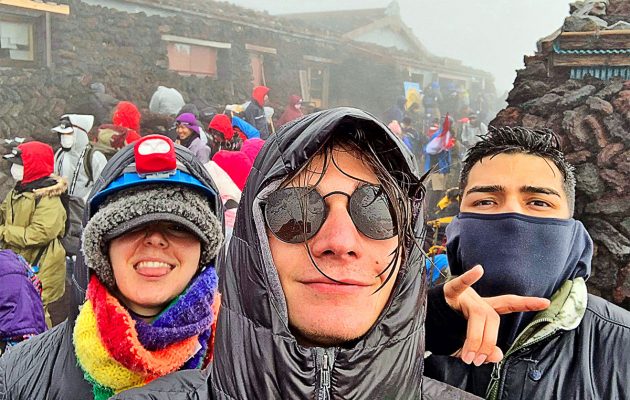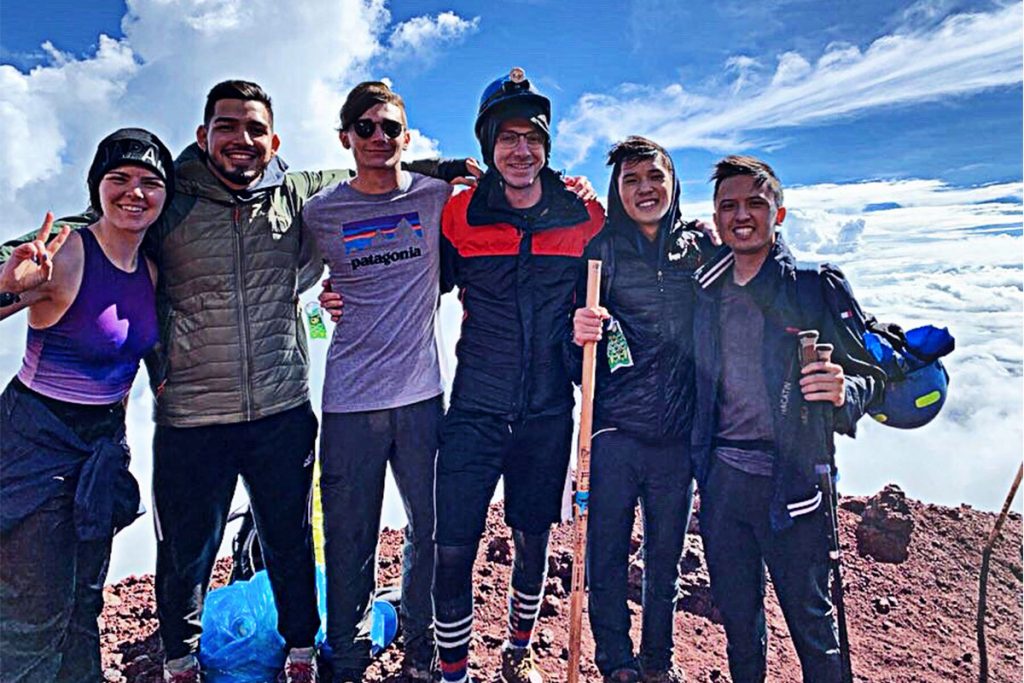Words Count: Justin Shrader

Mountain hiking during daylight amidst calm weather can have its erratic, exciting moments. Hiking Japan’s Mt. Fuji, a sacred, stratovolcanic structure of basaltic lava and rock resulting from sequences of volcanic activity, in the dark wee hours during typhoon season, tends to heighten the hiking experience to a whole other level.
Between periodic rain, 60 mph gusts of wind, dense fog and shifting terrain full of switchbacks, the experience took on a “surreal” quality of physical and mental significance, a kind of right-of-passage for Justin Shrader, a curious 21-year-old college student from San Marco, whose thoughts on the trip prove an understanding beyond his years.
Mt. Fuji, Japan’s tallest peak at 12,389 feet is still considered an “active” volcano (although the last eruption was in 1707). Shrader, a University of North Florida (UNF) student, first contemplated the idea of climbing the beast when he heard from his mother, Rachel Shrader of San Marco, that his sister, Cheyenne, who was teaching English to children in Japan, wanted to climb the famous mountain with her brother for her 23rd birthday.
Rachel, a successful real estate director with the Adecco Group and triathlete, has always encouraged her children to follow their heart. She talked with her son about the possibilities, and suggested he ask his best friend, Mynor Urrutia, if he’d like to accompany him. “Within a week we were fulfilling my sister’s birthday wish, researching Japan and booking flights,” recalled Shrader.

There was a lot to consider as Mt. Fuji, or “Fuji-san” as it is commonly called by the Japanese, has been a popular pilgrimage and recreational site for centuries. It is one of three sacred mountains and is climbed by more than 300,000 people every summer. Located 60 miles southwest of Tokyo, there are four major trails to choose from that offer different approaches to the summit, with rest areas, or “stations,” along the way providing amenities and lodging. Also, of interest are the numerous shrines at the base of the mountain, another testament to Mt. Fuji’s spiritual and historical significance.
Cheyenne, Justin and Mynor chose the Yoshida trail that leads to the summit (the 10th station) from the north side of Mt. Fuji. Like many climbers, they took a scenic toll road up Mount Fuji’s lower northern slopes starting at Kawaguchiko Town that took them to the start of their hike at the Fuji-Subaru Line Fifth Station.
“The fifth station was basically a crowded marketplace with restaurants, gear shops and a big open plaza where all the groups met to start the hike,” said Shrader. Part of a guided group of 15, they hiked the most popular trail for about eight hours before bunking down at a hostile in station eight where they had dinner and story-telling amongst a group of locals, Americans and Germans. “With all the fragmented volcanic rock the entire way up, it felt like hiking inclined gravel,” said Shrader.
The group started the next day at 1 a.m. with misting rain and ended up arriving at the peak before sunrise so they toured a volcano’s crater. “Touring the crater was breathtaking and despite the fog, being on the peak was a surreal experience,” said Shrader. He even shared the experience with his parents by face-timing them with a tiny WIFI router which “amazingly worked on top of the mountain.”
Because the trip to Japan was his first as an adult, it represented an occasion for self-growth for Shrader, who learned that the world was more integrated than he thought and to not miss out on opportunities no matter how far-out or scary they may seem. “Don’t think about it, just do it,” he said.
“I learned that when you push yourself your concept of the world grows and your ability to more fully relate to others grows, too,” said Shrader. He also discovered a respect for another culture, history and environment, and the meaning behind John Updike’s words, “You cannot help but learn more as you take the world into your hands. Take it up reverently, for it is an old piece of clay, with millions of thumbprints on it.”
The experience also heightened his desire to one day hike other major peaks of the world and reinforced his ultimate goal of giving back by starting or helping fund an environmental conservation foundation focused on marine animals, a passion that began after visiting Sea World as a young kid.
This desire to help animals, especially the over-fished and endangered shark species, was followed by a fascination with chemistry in high school and how chemical combinations create our world. Actually, it was his 10th grade chemistry teacher, Mr. Hervig, who turned around his drudgery of the subject along with a new understanding of why chemistry was important for his future. “Because of his enjoyment and application of chemistry, it went from my worst to my favorite subject,” said Shrader.
“Being on a STEM path, chemistry gave me a deeper understanding of how the universe works involving the most basic units of matter of what everything is comprised of,” said Shrader. “I find I can take principles learned from chemistry, the mechanics of it and apply it to physics, calculus, biology and even psychology to bring it to real life. Once you realize that this is something happening every day, you can break down the steps to what is happening in reality – from boiling water, to why a car accident happened, to understanding a friend’s angst might be a hormone imbalance.”
Having attended several community colleges and changed majors in the engineering field, Shrader is now a junior majoring in information technology at the University of North Florida because it’s applicable to any field. At only age 21, he continues expanding his awareness and goals. “It would be difficult to live every day without having the knowledge of chemistry and other subjects because they’re how the world works,” he explained. “We’re so caught up in social media, but none of this is significant when you look at the bigger picture through physics and mathematics, the language of the universe.
“No matter your age, we all have experiences that teach us who we are, what we’re made of, what we want to be and what we need to do to get there,” Shrader continued.
Perhaps in American journalist Sydney Harris, said it best in his syndicated column, “Strictly Personal.”
“The whole purpose of education is to turn mirrors into windows,” wrote Harris.
With his love of the environment, chemistry and adventure, Shrader is ahead of most young people in knowing himself and what he really wants, before taking on the world to do it.
By Christina Swanson
Resident Community News




 (4 votes, average: 4.00 out of 5)
(4 votes, average: 4.00 out of 5)

